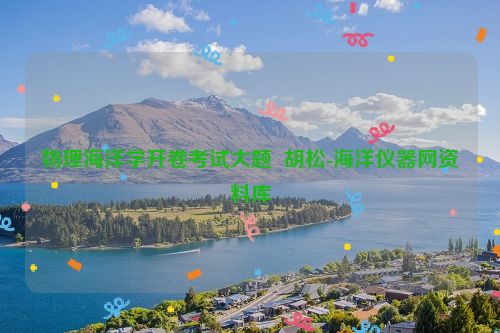1.inertial period:It is one half the time required for the rotation
of a local plane on Earth’s surface
2. geostrophic balance:Within the ocean’s interior away from the top and bottom Ekman layers, for horizontal distances exceeding a few tens of kilometers, and for times exceeding
a few days, horizontal pressure gradients in the ocean almost exactly balance
the Coriolis force resulting from horizontal currents. This balance is known as
the geostrophic balance.
3.pressure gradient: In atmospheric sciences (meteorology, climatology and related fields), the pressure gradient (typically of air, more generally of any fluid) is a physical quantity that describes which direction and at what rate the pressure changes the most rapidly around a particular location. The pressure gradient is a dimensional quantity expressed in units of pressure per unit length. The SI unit is pascal per metre (Pa/m)..维基百科
4. mixed layer :Wind blowing on the ocean stirs the upper layers leading to a thin mixed layer at the sea surface having constant temperature and salinity from the surface down to a depth where the values differ from those at the surface. The magnitude of the difference is arbitrary, but typically the temperature at the bottom of the layer must be no more than 0.02–0.1? colder than at the surface./ The oceanic or limnological mixed layer is a layer in which active turbulence has homogenized some range of depth维基百科
5.physical oceanography:p8
Physical Oceanography is the study of physical properties and dynamics of
the ocean. The primary interests are the interaction of the ocean with the atmosphere,
the oceanic heat budget, water mass formation, currents, and coastal
dynamics. Physical Oceanography is considered by many to be a subdiscipline
of geophysics.
6. The Ekman number is a dimensionless number used in describing geophysical phenomena in the oceans and atmosphere. It characterises the ratio of viscous forces in a fluid to the fictitious forces arising from planetary rotation. It is named after the Swedish oceanographer Vagn Walfrid Ekman.
7. thermocline.:Below the mixed layer, water temperature decreases rapidly with depth except at high latitudes. The range of depths where the rate of change, the gradient of temperature, is large is called the
8. double diffusion.:Here's what happens. Heat diffuses across the interface faster than salt, leading to a thin, cold, salty layer between the two initial layers. The cold salty layer is more dense than the cold, less-salty layer below, and the water in the layer sinks. Because the layer is thin, the fluid sinks in fingers 1-5cm in diameter and 10s of centimeters long, not much different in size and shape from our fingers. This is salt fingering. Because two constituents diffuse across the interface, the process is called double diffusion.p131
9.salinity: At the simplest level, salinity is the total amount of dissolved material in
grams in one kilogram of sea water. Thus salinity is a dimensionless quantity.
It has no units.
10 Reynolds number : In fluid mechanics, the Reynolds number (Re) is a dimensionless number that gives a measure of the ratio of inertial forces to viscous forces and consequently quantifies the relative importance of these two types of forces for given flow conditions.
11. Coriolis Force is the dominant pseudo-force influencing motion in a coor-dinate system fixed to the earth.

